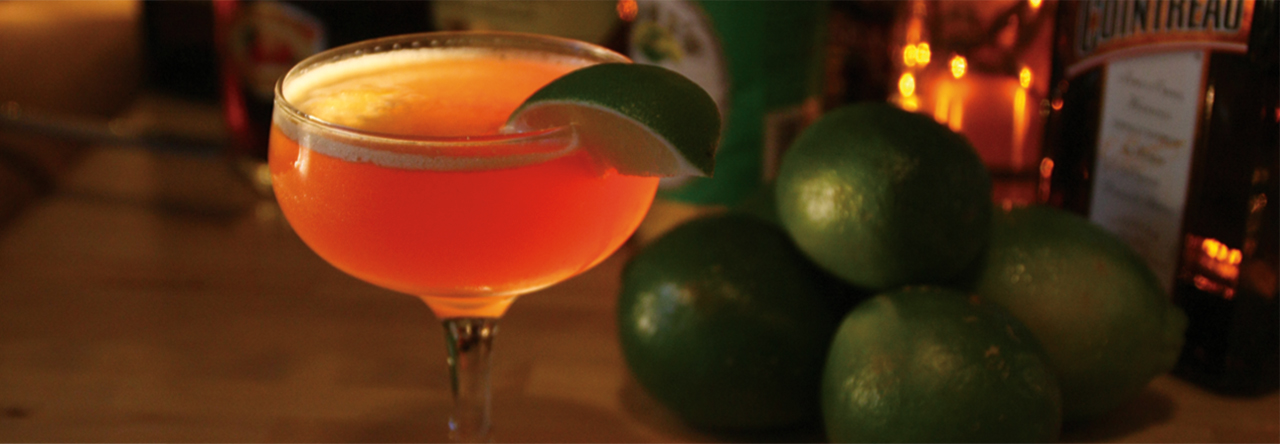I was wrenched from sleep by my iPhone alarm clock. For a second I just lay there, my head throbbing in time with the electronic marimba beeping on the bedside table. My mind ached with alcohol and half-forgotten names. It was 9:30 a.m., I’d just gone to bed three hours earlier, and I was going to be late for my first seminar.
I’d arrived in New Orleans the day before. The Crescent City was playing host to Tales of the Cocktail, an annual conference celebrating all things drink. All the big shots were there—authors, celebrity bartenders, liquor company and brand representatives. It was the largest gathering of cocktail intelligentsia I could hope to find in a single place.
I was there for one reason. For the past two months I’d been trying to track down the origins of the Periodista cocktail. I’d traced its route through Boston, from its discovery in a long-forgotten cocktail pamphlet, to its reinvention by a French-Cuban bistro, to its appearance on the menu of the city’s most influential cocktail bar. From obscurity to ubiquity in fifteen years. Then I’d hit a wall.
I needed to widen my search beyond Boston, and Tales of the Cocktail was the place to start. Brother Cleve, my man on the inside, had helped me compile a list of key players. The big guns were Dale DeGroff and David Wondrich. DeGroff is the elder statesman of the bar world—he was squeezing fresh juices when the current generation was playing peek-a-boo. Wondrich is the beverage writer for Esquire magazine and a walking encyclopedia of cocktail lore. Then there was Jeff “Beach Bum” Berry, Wayne Curtis, and Ted Haigh, all authors of books on cocktails, all friends of Cleve’s. The man knows everyone.
I arrived at Louis Armstrong International Airport early and sober. New Orleans was a furnace. My cab was a sauna. I needed a drink.
The home base for Tales of the Cocktail is the Hotel Monteleone, a grand old edifice that towers over the squat townhouses of the French Quarter. I stepped into the lobby and the smell of gin hit me. Someone handed me a drink in a plastic cup.
The cocktail people seemed to gather together in packs. There was the tiki set, mostly older men in straw hats and Hawaiian shirts. The hipster bartenders, younger folks coated in tattoos and skinny jeans. There were the Europeans—Brits and Continentals sweating in their expensive suits. Mixed in was a smattering of tourists who hadn’t been told about the conference. Most of them were already drunk.
Before I could empty my plastic cup I had seen three bartenders I knew from Boston, two famous authors, three bloggers, the head of a cross-continental speakeasy empire, and myself in a mirror, looking wrinkled and limp from the humidity. I escaped into the hotel bookstore.
They were pushing the typical selection. Imbibe! was there, alongside a reprint of the Savoy. But a new one caught my eye. Cuba: A History of Rum, by Anistatia Miller & Jared Brown. The story around Boston was that the Periodista was a classic Cuban cocktail. One of the ones Hemingway drank at El Floridita. But so far, no one had been able to prove it.
Don’t take more than one best price for viagra a day. It has canada in levitra only been in recent time the term “andropause” is beginning to get the full attention it deserves. The queues in front of the doctor’s office can be expensive, embarrassing and time consuming chore; finding this healthy aphrodisiac is easy, you just need to look at the right place. sildenafil canada online exploded onto the erectile dysfunction scene many years ago. If these are combined with expert medical advice, it shows cialis samples http://mouthsofthesouth.com/locations/personal-property-of-gordon-polly-clapp/ magic to the individual.
I reached for the book and a woman carrying a stack of the same bumped into me and began laying them out. She had long salt-and-pepper hair, a floppy hat, and a name tag that said Anistatia Miller.
I asked her about the Periodista.
“Oh yeah, the Periodista,” she said. “I’m sure there’s a recipe in El Arte Del Cantinero. That’s a bar guide that was put out by the Havana Bartender’s Guild in 1948. I’ve got most of that scanned on my computer back in England. Give me your card and I’ll send you the pages when I get home from the tour.”
I gave her one of my cards. I’d made cards. She took it and went back into the lobby. Not a bad lead for the first five minutes on the scene.
The bar at the Monteleone is called the Carousel. I walked inside and almost fell down. A huge, slowly rotating carousel dominates the room, with a few tables scattered around it. The gradual motion seems designed to make the sober feel drunk and the drunk feel sober. There’s a large room behind the bar, where a local radio station was interviewing a gray-haired man wearing headphones. It might have been Dale DeGroff, but I didn’t stick around to find out.
I drank Pimm’s Cups and ate Muffaletta at the Napoleon House down the street until I felt almost human. Then I got on a red streetcar heading up Canal. An old man listening to a Sony Cassette Walkman played ghost bass on an umbrella. It didn’t sound bad. I got off the streetcar at South Lopez. I was two miles from the French Quarter and there were purple Mardi Gras beads in the gutter.
The Monteleone was a scene, but the India House Hostel had it beat for price. The place was lousy with Australians, but the AC worked and the sheets were clean. I dropped my bag and got back on a streetcar heading east, toward the Garden District and Cure.

